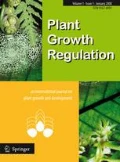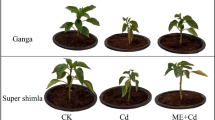Abstract
The accumulation of conjugated and free polyamines in plants is very important for their protection against oxidative stress induced by abiotic factors. In the present study, the species halophytic plant Mesembryanthemum crystallinum L. was used as a model system in which the process of Crassulacean Acid Metabolism induction is linked with oxidative stress, especially under salinity conditions. A comparative analysis of the content of free polyamines, perchloric (PCA)-soluble and PCA-insoluble conjugated polyamines in mature leaves and roots was carried out with plants exposed to salinity. It was found that adult leaves and roots under normal conditions or salinity (400 mM NaCl) contained all types of free polyamines (putrescine, spermidine, spermine, and cadaverine). In leaves only PCA-insoluble conjugates were found, which showed a tendency to grow with increased duration of salt action (1.5–48 h). In contrast to leaves, in roots all forms of polyamine conjugates (PCA-soluble and -insoluble) were detected. However, the formation of all conjugates, especially PCA-soluble forms in roots, was sharply inhibited by salt shock (400 mM NaCl, 1.5 h) or exogenous cadaverine (1 mM) treatment. PCA-soluble conjugates of cadaverine in roots were found only when the treatment was carried out in combination with aminoguanidine (1 mM), as a result of diamine oxidase inhibition and consequently a decreasing of H2O2 production in plant cells. The activation of diamine oxidase and guaiacol peroxidase by NaCl or exogenous cadaverine was observed in leaves and roots. Thus, the activation of oxidative degradation of polyamines combined with H2O2–peroxidase reaction in cells are involved in the regulation of free and conjugated polyamines titers under salinity.
Similar content being viewed by others
Abbreviations
- PA:
-
Polyamine
- Put:
-
Putrescine
- Spd:
-
Spermidine
- Spm:
-
Spermine
- Cad:
-
Cadaverine
- Dap:
-
Diaminopropane
- DAO:
-
Diamine oxidase
- AG:
-
Aminoguanidine
- GuPX:
-
Guaiacol peroxidase
- Cat:
-
Catalase
- H2O2 :
-
Hydrogen peroxide
- CAM:
-
Crassulacean acid metabolism
References
Adams P, Nelson DE, Yamada S, Chmara W, Jensen RG, Bochnert HJ, Griffits H (1998) Growth and development of Mesembryanthemum crystallinum (Aizoaceae). New Phytol 138:171–190
Aronova EE, Shevyakova NI, Stetsenko LA, Kuznetsov VlV (2005) Cadaverine-induced induction of superoxide dismutase gene expression in Mesembryanthemum crystallinum L. Dokl Biol Sci 403:257–259
Asthir B, Duffus CM, Smith RC, Spoor W (2002) Diamine oxidase is involved in H2O2 production in the chalazal cells during barley grain filling. J Exp Bot 53:677–682
Bagni N, Pistocchi R (1991) Uptake and transport of polyamines and inhibitors of polyamine metabolism in plants. In: Slocum RD, Flores HE (eds) Biochemistry and physiology of polyamines in plants. CRC Press, Boca Raton, pp 105–118
Bagni N, Tassoni A (2001) Biosynthesis, oxidation and conjugation of aliphatic polyamines in higher plants. Amino Acids 20:301–317
Basu HS, Schwietert HCA, Feuerstein BG, Marton LJ (1990) Effect of variation in the structure of spermine on the association with DNA and the induction of DNA conformational changes. Biochem J 269:329–334
Bors W, Langebartels C, Michel C, Sandermann H (1989) Polyamines as radical scavengers and protectants against ozone damage. Phytochemistry 28:1589–1595
Bouchereau A, Aziz A, Larher F, Matin-Tanguy J (1999) Polyamines and environmental challenges: recent development. Plant Sci 140:103–123
Bradford MM (1976) A rapid and sensitive method for the quantitatio of microgram quantities of protein utilizing the principle of protein–dye binding. Anal Biochem 72:248–254
Brennan T, Frenkel C (1977) Involvement of hydrogen peroxide in the regulation of senescence in pear. Plant Physiol 59:411–416
Chance B (1954) Special methods: catalase. In: Glick D (ed) Methods of biochemical analysis. Interscience Publishers, New York, p 408
Dondini L, Del Duca S, Dall’Agata L, Bassi R, Gastaldelti M, Della Mea M, Di Sandro A, Claparols I, Serafini-Fracassini D (2003) Suborganellar localisation and effect of light on Helianthus tuberosus chloroplast transglutaminases and their substrates. Planta 217: 84–93
Duhazé C, Gouzerh G, Gagneul D, Larher F, Bouchereau A (2002) The conversion of spermidine to putrescine and 1,3-diaminopropane in the roots of Limonium tataricum. Plant Sci 163:639–646
Flores HE, Galston AW (1982) Analysis of polyamines in higher plants by performance liquid chromatography. Plant Physiol 69:701–708
Folk JE (1980) Transglutaminases. Annu Rev Biochem 49:517–531
Havelange A, Lejeune P, Bernier A, Kaur-Sawhney R, Galston AW (1996) Putrescine export from leaves in relation to floral transition in Sinapis alba. Physiol Plant 96:59–65
Igarashi K, Kashiwagi K (2000) Polyamines: mysterious modulators of cellular functions. Biochem Biophys Res Comm 271:559–564
Johnson CM (1957) Comparative chlorine requirements of different plant species. Plant Soil 8:337–353
Kuznetsov VlV, Rakitin VYu, Duong DB, Sadomov NG, Dam DB, Stetsenko LA, Shevyakova NI (2002) Does polyamine participate in long-distance translocation of stress signal in plants? Russ J Plant Physiol 49:120–130
Langerbartels C, Kerner K, Leonardi S, Schraudner M, Trost M, Heller W, Sanderman H (1991) Biochemical plant responses to ozone. 1. Differential induction of polyamine and ethylene biosynthesis in tobacco. Plant Physiol 95:882–887
Martin-Tanguy J (1985) The occurence and possible functions of hydrocinnamoyl acid amides in plant. Plant Growth Regul 3:381–399
Martin-Tanguy J (1997) Conjugated polyamines and reproductive development: biochemical, molecular and physiological approaches. Physiol Plant 100:675–688
Martin-Tanguy J (2001) Metabolism and function of polyamines in plants: recent development (new approaches). Plant Growth Regul 34:135–148
Mehta HS, Saftner RA, Mehta RA, Davies PJ (1994) Identification of posttranscriptionally modified 18-kilodalton protein from rice as eukariotic translocation initiation factor 5A. Plant Physiol 106:1413–1419
Miszalski Z, Ślesak I, Niewiadomska E, Bączek-Kwinta R, Lüttge U, Ratajczak R (1998) Subcellular localization and stress responses of superoxide dismutase isoforms from leaves in the C3-CAM intermediate halophyte Mesembryanthemum crystallinum L. Plant Cell Environ 21:169–178
Nag S, Saha K, Choudhuri A (2000) A rapid and sensitive assay method for measuring amine oxidase based on hydrogen peroxide-titanium complex formation. Plant Sci 157:157–163
Negrel J (1989) The biothynthesis of cinnamoylputrescine in callus tissue cultures of Nicotiana tabacum. Phytochemistry 28:477–481
Negrel J, Lherminier J (1987) Peroxidase-mediated integration of tiramine into xylem cell walls of tobacco leaves. Planta 72:494–501
Serafini-Fracassini D, Del Duca S, Beninati S (1995) Plant transglutaminases. Phytochemistry 40:355–365
Shevyakova NI, Rakitin VYu, Duong DB, Sadomov NG, Kuznetsov VlV (2001) Heat shock-induced cadaverine accumulation and translocation throughout the plant. Plant Sci 161:1125–1133
Shevyakova NI, Stetsenko LA, Mescheryakov AB, Kuznetsov VlV (2002) The activity of the peroxidase system in the course of stress-induced CAM development. Russ J Plant Physiol 49:598–604
Shevyakova NI, Shorina MV, Rakitin VYu, Stetsenko LA, Kuznetsov VlV (2004) Ethylene-induced production of cadaverine is mediated by protein phosphorylation and dephosphorylation. Dokl Biol Sci 395:127–129
Shorina MV, Ragulin VV, Kuznetsov VlV, Shevyakova NI (2005) Are cadaverine and ethylene involved in the induction of CAM photosynthesis in the common ice plant. Dokl Biol Sci 400:115–120
Ślesak I, Karpińska B, Surówka E, Miszalski Z, Karpiński S (2003) Redox changes on chloroplast and hydrogen peroxide are essential for regulation of C3–CAM transition and photooxidative stress responses in the facultative CAM plant Mesembryanthemum crystallinum L. Plant Cell Physiol 44:573–581
Takahama U (1989) A role of hydrogen peroxyde in the metabolism of phenolics in mesophyll cells of Vicia faba L. Plant Cell Physiol 30:295–301
Tiburcio AF, Altabella T, Borrell A, Masgraw C (1997) Polyamine metabolism and its regulation. Physiol Plant 100:664–676
Torrigiani P, Serafini-Fracassini D, Fara A (1989) Diamine oxidase activity in different physiological stages of Helianthus tuberosus tuber. Plant Physiol 89:69–73
Winter K, Holtum JAM (2005) The effects of salinity, crassulacean acid metabolism and plant age on the carbon isotope composition of Mesembryanthemum crystallinum L., a halophytic C3–CAM species. Planta 222:201–209
Yamasaki H, Sakihama Y, Ikehara N (1997) Flavanoid-peroxidase reaction as a detoxification mechanism of plant cells against H2O2. Plant Physiol 115:1405–1412
Ye XS, Avdiushko SA, Kuc J (1994) Effect of polyamines on in vitro phosphorylation of soluble and plasma membrane proteins in tobacco, cucumber and Arabidopsis thaliana. Plant Sci 97:109–118
Acknowledgements
The authors are grateful to Professor Nella L. Klyachko from the Institute of Plant Physiology (Moscow, Russia) for valuable assistance in translating this manuscript from Russian into English. This work was partially supported by the Russian Foundation for Basic Research (project no. 04-04-48392) and by the program of the Presidium of RAS (Cell and Molecular Biology).
Author information
Authors and Affiliations
Corresponding author
Rights and permissions
About this article
Cite this article
Shevyakova, N.I., Rakitin, V.Y., Stetsenko, L.A. et al. Oxidative stress and fluctuations of free and conjugated polyamines in the halophyte Mesembryanthemum crystallinum L. under NaCl salinity. Plant Growth Regul 50, 69–78 (2006). https://doi.org/10.1007/s10725-006-9127-1
Published:
Issue Date:
DOI: https://doi.org/10.1007/s10725-006-9127-1




